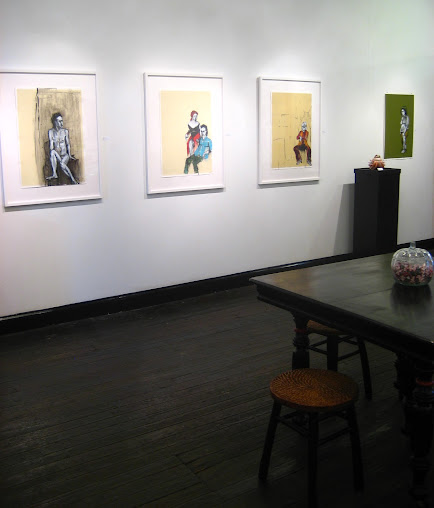 |
| Mike DeCapite reading at The Literary Cafe, Cleveland, March 2012 |
The occasion: Mike DeCapite's prose chapbook, Radiant Fog, has
just debuted, and Jim Mason was reading with him as well. Mike was born and raised in Cleveland, the son of another Cleveland
novelist, Ray DeCapite. Since his 20s, Mike has lived in San Francisco, London,
and now (for many years) New York. He's a wonderful writer of place, of getting to and from
places, and especially of moments in time and place. His recent piece over at
Rust Belt Chic, "December," describes a moment in a cold Cleveland
evening and reads like a gem of a prose poem. His novel Through the Windshield has been called a “Whitmanesque hymn to
Cleveland” (Jocko Weyland, Rain Taxi).
I loved his last chapbook, Creamsicle Blue, which traveled from New York to
Cleveland to San Francisco and always back to New York. By his own admission,
his writing often tells stories but he doesn't write stories per se. As a
reader, I love watching him achieve a very delicate balance of description and
revelation: as if his art is that of finding the right ratio of interior to
exterior. What does a hidden road along the Cuyahoga River have to do with a
particular feeling from 1982? Everything. The writer can taste the feeling in
his mouth in the same way he can taste the cold air of that particular night,
and the reader can taste it, too. Mike DeCapite has the touch for locating
himself as a narrator.
Last night's reading was held at The Literary Café. I had
the privilege of reading there with Mike in March of this year: The small bar they
call "The Lit" has been serving beer and shots on Literary Road in
Tremont since late 1991, and Mike DeCapite has been reading there something like once or twice
a year for two decades. The bar itself (which hosts monthly readings and weekly life drawing sessions) is lined in a warm pine wood paneling
and exposed brick, with touches of brightness everywhere—Christmas lights,
framed drawings, a glowing face in the window, a fake fireplace burning away.
The warmth of the customers, who seem to have known
each other forever, is also palpable.
 |
| Greetings from The Lit |
As a reading audience, the scene at The Lit reminded me most
of The New Yinzer Presents readings held at ModernFormations Art Gallery in
Pittsburgh, or the Last Sunday, Last Rites reading series at the Baltimore
Hostel. In each case, the audience knows each other well, and the coziness starts
there. (People congregate in the center of the room and laugh and embrace,
whereas at some New York readings, people arrive in ones and twos and hug the
walls. Looking out from the stage, the room appears empty.) Beer flows at each
of these reading series, but it doesn't interrupt the audience being highly
attentive once the reading begins. At The Lit, I was especially impressed; the
bar laughed heartily at many of my most subtle almost-jokes, at life's little
ironies embedded in not-funny prose. They really got everything I was doing as
a writer. In the end, I realized that I owed at least some thanks for that to
Mike DeCapite. The degree to which our literary sensibilities overlapped was
the degree to which his audience could easily pick up on my innuendos: These
people were his readers—many had been reading and listening to him read for at
least 20 years. This left me to ponder on the process and patience of building a long-term audience
(in a city where you don't live anymore, no less!).
 |
| Graffiti on Cleveland Museum of Art's renovations |
Cleveland: An old friend was going to meet me there from Ann Arbor. With the pending blizzard, we would have
stayed in a hotel room, and in fact he got a last-minute great deal on the
Renaissance Cleveland, right there in Public Square. I've only been to
Cleveland a few times, but from Public Square I would have known where to eat
breakfast (around the corner, inside the landmark Terminal Tower), how to get the
city bus to the reading or to the Cleveland Museum of Art (the bus is $2.25,
the museum is free), and which direction the Megabus stop was (in fact it's
steps from the hotel). Did you know that Cleveland's city bus system runs 24
hours? Or that they have a bus line that's as close to being a light rail as
you can get? It's similar to Pittsburgh's Busway, but where Pittsburgh's
system avoids the traffic lights but is off the beaten path, Cleveland's Healthline
(subsidized by the Cleveland Clinic) has a dedicated lane right down Euclid
Avenue, the main thoroughfare between downtown and Case Western and the art museum. Enclosed bus stops have machines for bus tickets, which aren't collected by drivers but bought on an honor system; all doors open at every stop, which speeds service to an impressive efficiency. This all feels a bit like Rust Belt Luxury to me.
Pittsburgh isn't in the "snow belt" of lake effect
snowfall, but it feels like a Great Lakes city here this weekend. The wind is blowing
fierce and cold from the west, much colder than we've felt in a long time, and last night I went to bed with a hat on. But
today I'm feeling, if not warm, then strong enough to handle the cold. I want to say it has something to do with being bundled up in the clothes I'd
packed for a potential blizzard weekend in Cleveland and Ann Arbor. See you next time.












